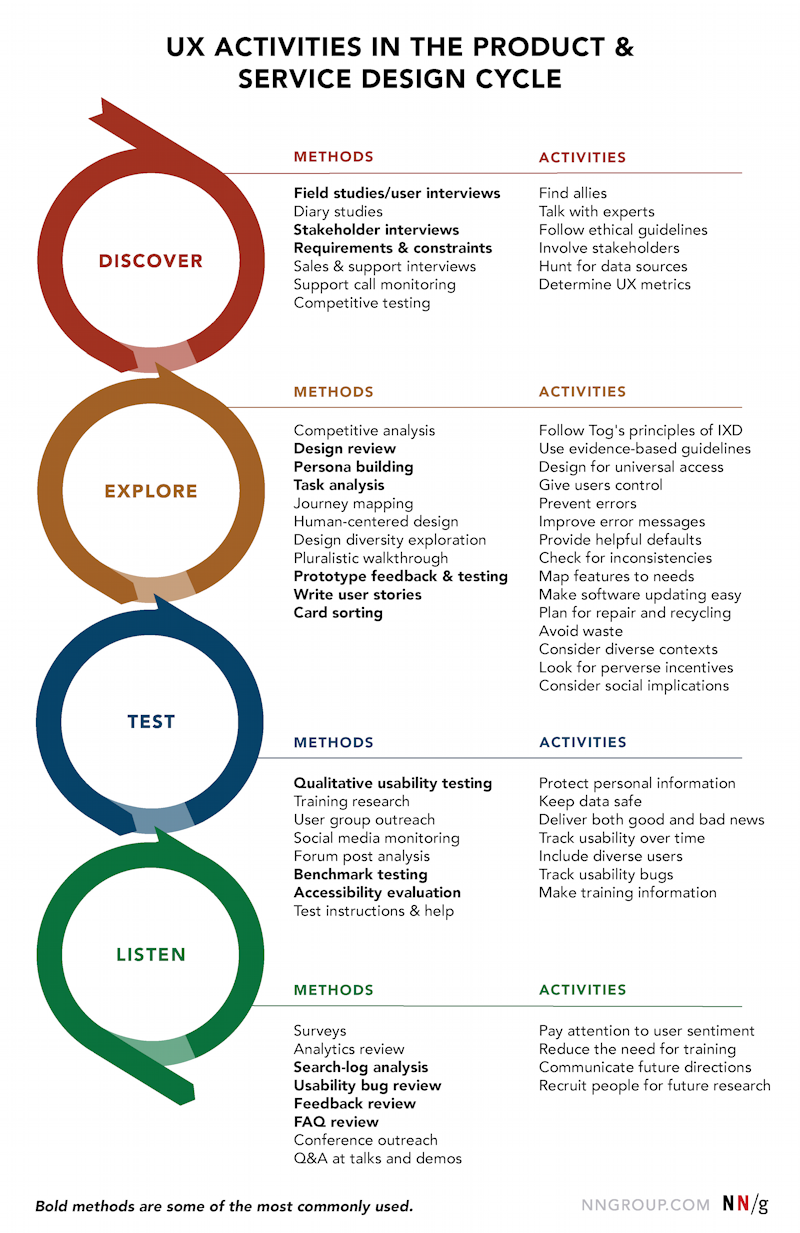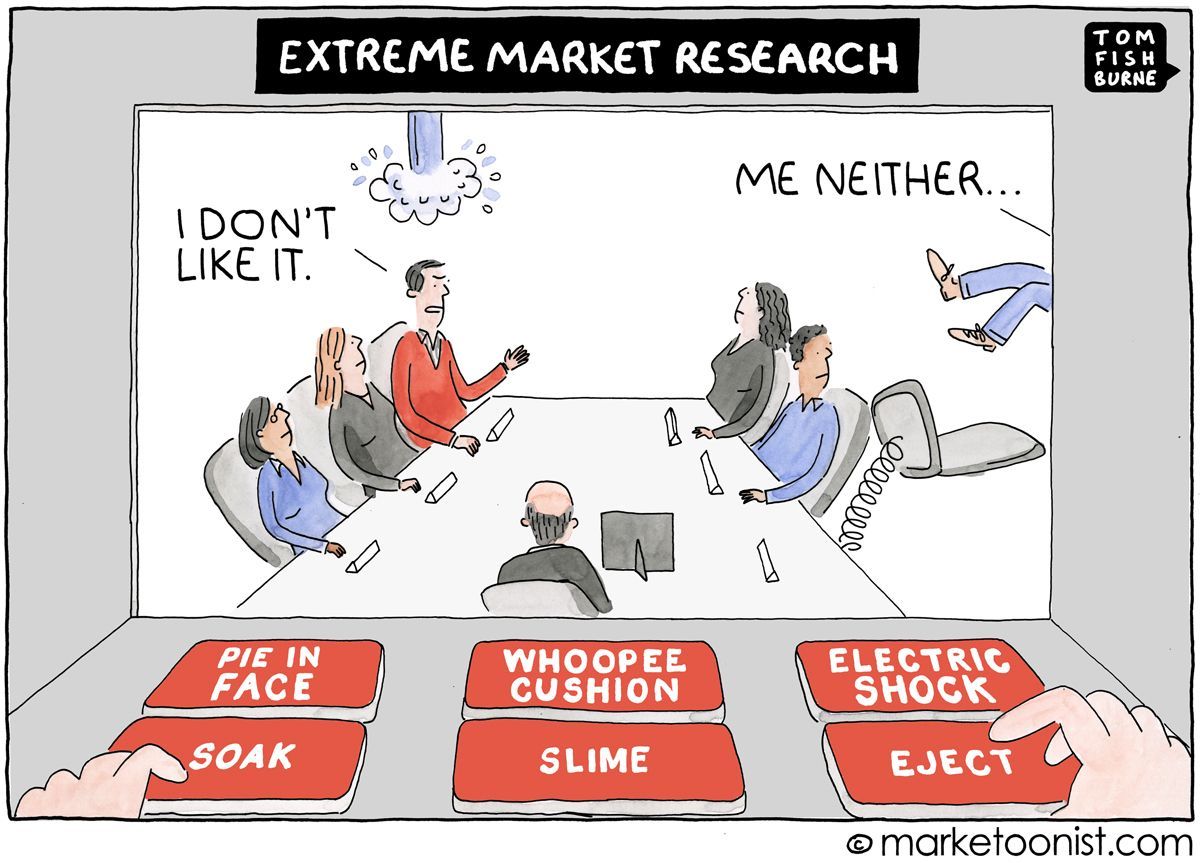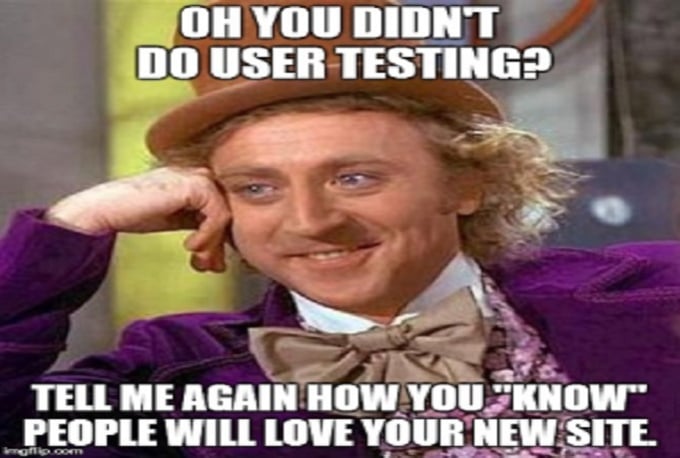User research is like the milk to our cereal, except if you’re lactose intolerant, then it’s more like the salt to our pepper. Basically, we’re like yin and yang, inseparably interconnected.
Metaphors aside, user research is a crucial part of product development that can make or break a product’s success. User research should be an ongoing process. By continuously collecting feedback from users, a team can challenge their assumptions and biases, make sure their roadmap stays on target (focused on what’s ACTUALLY useful for their customer), while always having evidence they can refer to when making product and strategy decisions. In this way, user research can help improve the user experience, increase customer satisfaction, and ultimately, drive business growth.
But with so many user research methods available, it can be overwhelming to know where to start. Fear not, young Padawan! We’ve compiled a list of our top five user research methods, and, more importantly, when to use them. So, let’s dive in!
P.S hopefully you like constructive criticism more than Ian!
@tldv.io We love constructive criticsm #productmanager #product #tech #productmanagement #corporatehumor #startup
♬ original sound - tldv.io - AI Meeting Recorder
An Overview of User Research Methods and When to Use Them
Before we dive headfirst into the top 5 user research methods and when to use which UX research method, let’s start with a brief overview of the different methods and show them alongside a timeline of product development. This will help give you an idea of when in the product journey certain styles of research should be employed.
The NNGroup breaks the product design cycle into four categories of UX research methods.

The four elements: Discover, Explore. Test, and Listen are great to keep in mind. However, our focus here will be on five specific methods of user research that you can implement. We’ll let you know where they should go in your product development cycle.
- User interviews: Interviews are best suited for the early stages of product development when teams are exploring user needs and pain points.
- Focus groups: Focus groups are useful for gathering insights on user attitudes and perceptions, not to mention identifying trends and patterns in user behavior. They are best suited for early-to-mid stages of product development.
- Card sorting: Card sorting is useful for designing or reorganizing a product’s information architecture or navigation and is best suited to the exploratory stages of product development.
- User testing: User testing is useful throughout the entire product development process but it’s particularly important in the later stages of product development.
- Surveys: Surveys are useful for gathering quantitative data on user preferences, behaviors, and demographics, and are best suited for later stages of product development where you listen to your users.
There are dozens more user research methods if you’re interested, but for today, we’re gonna hone in on these five.
Now that we’ve covered the basics, let’s dive deeper into our top five user research methods.
Top 5 UX Research Methods and When to Use Them
1. User Interviews
What are User Interviews?
Treat user interviews as if you’re going on a first date with your user. Get to know each other, explore your likes and dislikes together, and see if there’s a spark. Maybe (definitely) don’t lean in for a kiss at the end, but otherwise you’re golden! In other words, interviews are an excellent way to gather qualitative data on user needs and pain points. By speaking directly with users, you can gain a deeper understanding of their motivations, preferences, and behaviors.
When to do User Interviews?
User interviews are best suited for the early stages of product development when teams are exploring user needs and pain points. Conduct interviews with a small group of users to identify patterns and themes. Check this no bullsh*t guide for the best advice for conducting user interviews.
User Interview Tools
There’s a wide variety of tools you can use to help with conducting user interviews. Firstly, unless you’re living in the 1990s, you’ll want a video conferencing platform like Zoom or Google Meet.
Secondly, you’ll want some kind of software to partner with this that can record, transcribe, and make your interview insights easy to share with your team and stakeholders. Introducing tl;dv, the one stop shop for all things relating to user interviews.
Not only are the majority of its features completely free (forever!), it also makes creating clips, highlights and reels of your interviews easier than ever. And the easy-to-use meeting library acts as a UX research repository for all your user interviews!
Share with a simple copy/paste, or with one click if using one of tl;dv’s many integrations (Salesforce, Slack, Notion, Hubspot, etc…). You can even tag a colleague who absolutely needs to see a part of this interview and they’ll get an email with a link to the exact moment of the video/transcript where you tagged them. Couldn’t be easier.
As a much-loved remote UX research tool, tl;dv is paving the way for a new level of efficiency with user interviews. Integrating with AI to generate automatic notes about what was said, as well as meeting summaries, tl;dv is one step ahead of the rest when it comes to online meeting recorders that transcribe, translate, and allow you to edit your videos.
2. Focus Groups

What are Focus Groups?
If user interviews have the intimacy of a first date, focus groups are more like a party where you invite your users to hang out (typically 6-10) and chat about your product. You get similar benefits to interviews, only your users can bounce ideas off each other, leaving you to identify trends and patterns in user behavior that you may not have noticed from one individual. Focus groups are an excellent way to gather insights on user attitudes, test new product ideas, gather feedback on prototypes, or get a sense of how users feel about a particular issue.
When to do Focus Groups?
Focus groups are best suited for the early stages of product development, when you’re still exploring new ideas and concepts. They can help you identify potential pain points and opportunities for improvement, as well as generate new ideas for features and functionality. However, focus groups can be time-consuming and expensive, so they may not be the best choice for every project.
Tools for Focus Groups
- Focus Group Finder: An online tool that helps you find and recruit participants for your focus group. It’s super easy to use and can get you a focus group fast.
- Liveminds: A platform that enables you to conduct focus groups online and analyze the results in real-time.
- Dscout: A mobile research tool that lets you capture insights from users in their natural environments.
3. Card Sorting
What is Card Sorting?
Card sorting is a research method used to understand how users categorize and prioritize information. Participants are given a set of cards, each containing a piece of information (such as a feature, functionality, or topic), and are asked to group the cards into categories that make sense to them. This can help designers and researchers understand how users think about information architecture and navigation, and can inform the development of more intuitive and user-friendly interfaces.
By learning how to think like your users, you learn how to build a product that they’ll love. It’s a great tactic for those looking to get into the mind of their users.
When to do Card Sorting?
Card sorting is best used in the early stages of information architecture design, when you are working on organizing information and defining the structure of your product. It can also be used later in the design process to test and validate your design choices. Card sorting can be done both in-person and online, and is often used in combination with other research methods to get a more complete understanding of user needs and preferences.
Tools for Card Sorting:
- OptimalSort: An online tool for remote card sorting and tree testing that’ll get you thinking like your users in no time.
- UserZoom: A research platform that includes card sorting and tree testing capabilities, as well as other UX research methods for an all-round approach.
- Morae: A user testing software that includes a card sorting feature for in-person research sessions.
4. User testing

What is User Testing?
User testing is one of the most common and effective methods of user research. It involves observing users as they interact with a product or prototype, and gathering feedback on the user experience. User testing can be done in-person, remotely, or through online surveys. There are also dozens of different ways user testing can be conducted, from A/B testing to heat mapping, you can use analytical tools to get to the heart of your users’ decisions.
When to do User Testing?
User testing is most effective during the concept testing and usability testing stages of product development. During the concept testing stage, user testing can help you identify areas for improvement in your product concept and validate your overall value proposition. What’s important is that you write concept testing survey questions that align with the desired information you want to obtain. During the usability testing stage, user testing can help you identify and address any usability issues before launch.
Tools for User Testing
- UserTesting: Aptly named, this platform allows you to quickly and easily recruit participants, run tests, and analyze results.
- Hotjar: Hotjar is the best heat mapping tool in town, allowing you to figure out exactly where your users are clicking, and more importantly, where they’re not.
- Maze: Maze is a powerful user testing platform that allows you to create and conduct usability tests on digital products. Similarly to UserTesting, you can easily set up tests, recruit participants, and analyze the results to gain insights. You can also do A/B testing, user feedback collection, and even more advanced analytics.
5. Surveys
What are Surveys?
Surveys are some of the most popular ways for product teams to interact with their users. You ask a large group of users their opinions and preferences, and keep a tally of the answers so that you can gain a deeper understanding into your customer’s wants and needs. Surveys often struggle to be as useful as they could, however, because they frequently fall victim to one bias or another. By using the Mom Test when planning your survey questions (or during user interviews) you can be sure to limit any biases – even those you may not know you had.
With that word of warning in mind, surveys are an excellent way to gather quantitative data on user preferences, behaviors, and demographics. By using surveys, you can collect large amounts of data quickly and easily.
When to do Surveys?
Surveys are best suited for later stages of product development when you need to collect quantitative data on a specific feature or aspect of your product. They help you get feedback on what’s already been created, but they can also be used to gather ideas for future features or upcoming iterations.
Survey Tools
Check out the following survey tools to help you in your never ending quest for better user research:
- Google Forms: Forms is a simple and free survey tool that integrates seamlessly with other Google apps. It’s easy to use and well worth a look.
- SurveyMonkey: SurveyMonkey is a popular survey tool with a wide range of features and options. It’s one of the best survey platforms in the business.
- Typeform: Typeform is a survey tool known for its visually appealing and interactive forms. It knows the struggles of getting people to fill out surveys and uses clever design tactics to increase engagement.
Putting it All Together
User research should be a continuous process throughout the product development journey. By continuously collecting feedback from users, a team can challenge their assumptions and biases, make sure their roadmap stays on target, and always have evidence to refer to when making product and strategy decisions. Different types of user research are appropriate for different stages of product development, from the very early ideation stage to the collection of quantitative data regarding a very specific feature of a sophisticated product.
To summarize, the five UX research methods and when to use them are:
- User Interviews: When you want to gain a deeper understanding of your users’ thoughts, feelings, and behaviors. It’s great for concept testing in the discovery phase.
- Focus Groups: When you want to explore new ideas and concepts, and identify the pain points of your users. It’s a fantastic user research method for the discovery and exploratory research phase.
- Card Sorting: When you want to plan your website or app’s navigation and make sure that it’s as easy to use as possible. This is a brilliant method to have in your bag during the exploration phase as it will help a lot when it comes to usability testing.
- User Testing: When you want to identify and address usability issues before your product launches. This is great for the analysis and testing stage.
- Surveys: When you want to get quantitative data on specific features or functions so you can figure out what’s working and what you can improve on. Surveys are for the listening phase at the end of the product cycle when you want to know how you can improve further.
Ultimately, the best way to approach user research is to be flexible and adaptable. Don’t be afraid to experiment with different methods and adjust your approach based on your findings. With the right mix of user research methods and a commitment to ongoing learning, you can create products that truly meet the needs of your users and drive business success.
That’s what we all want in the end, right?





